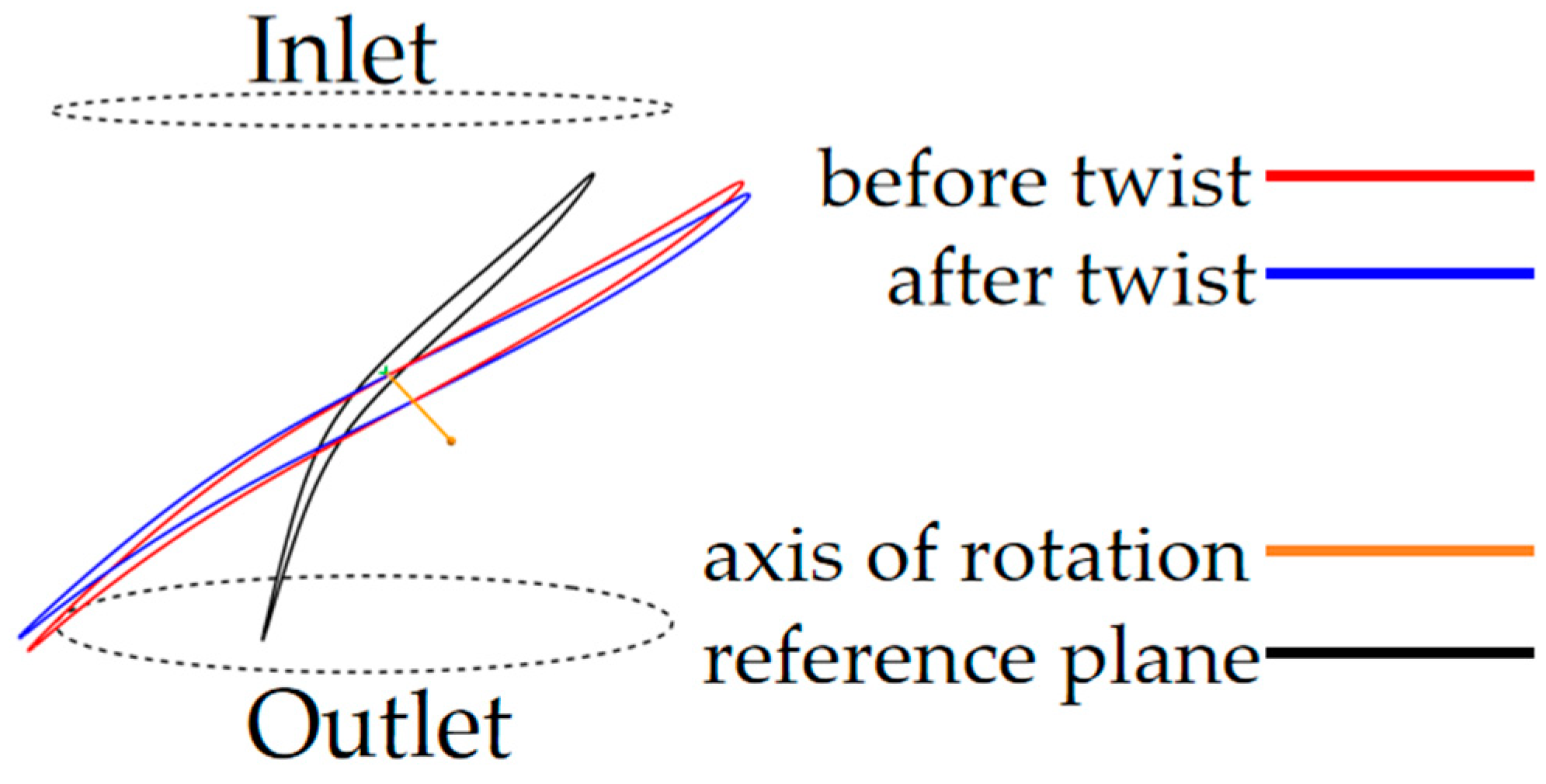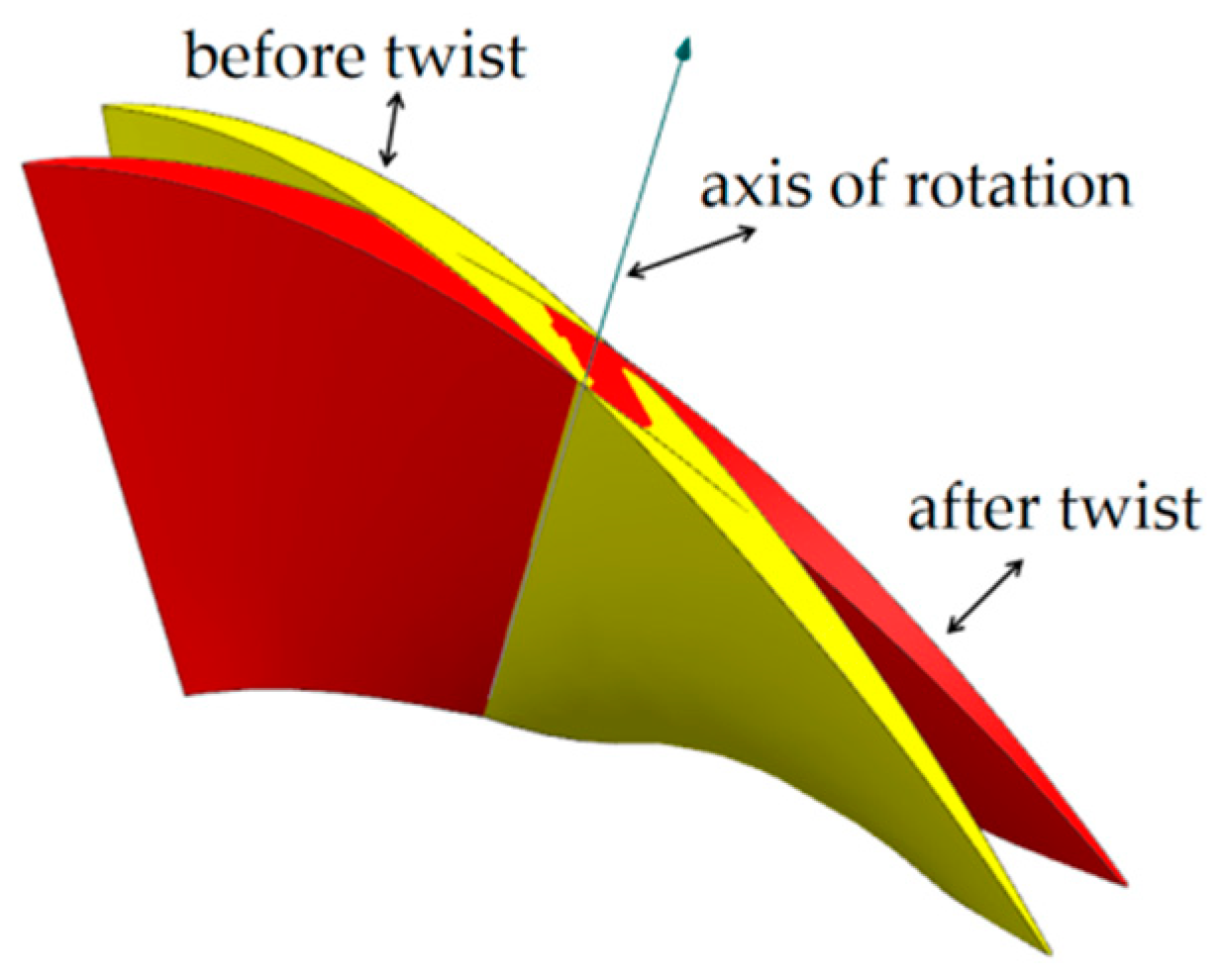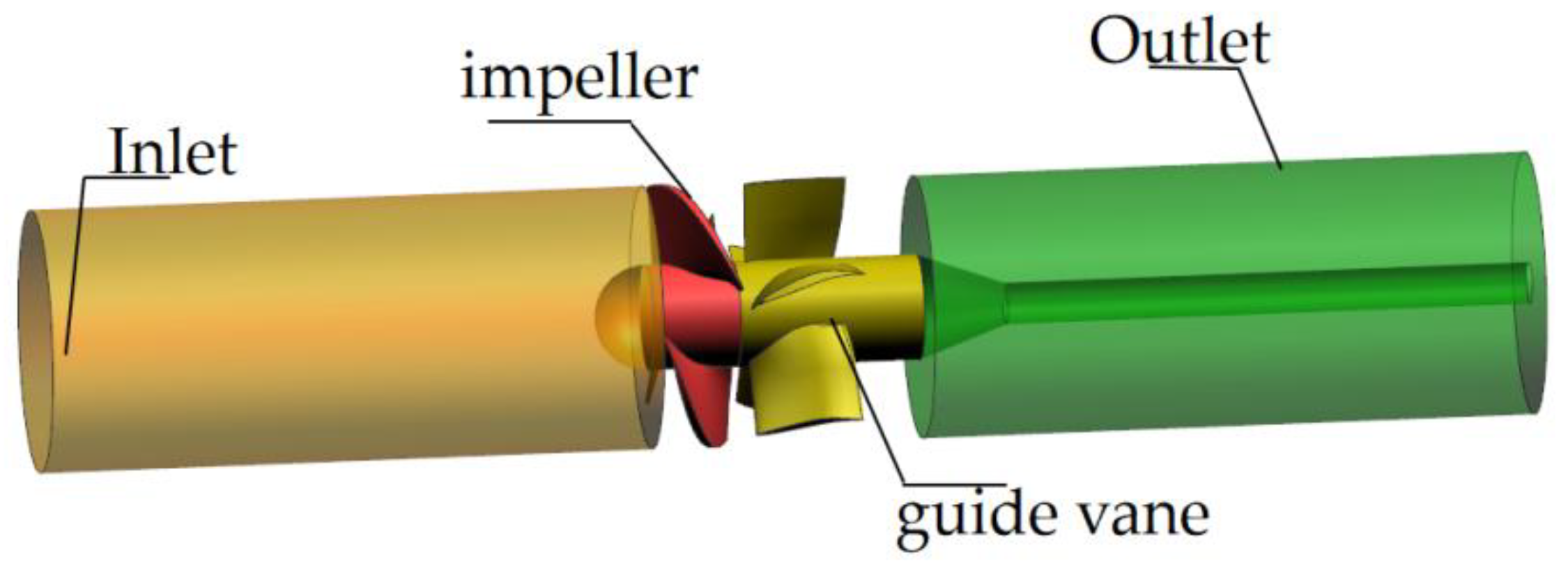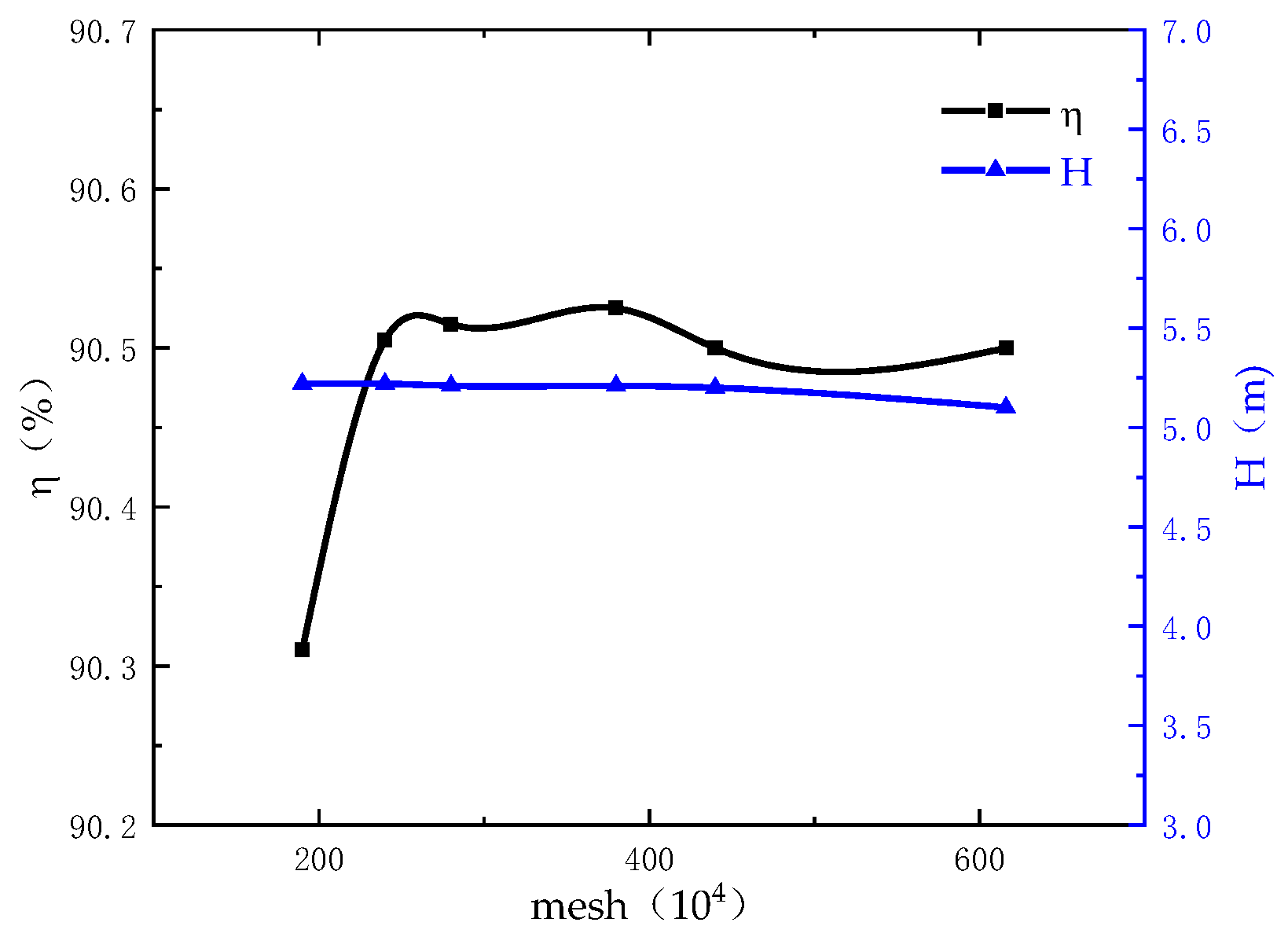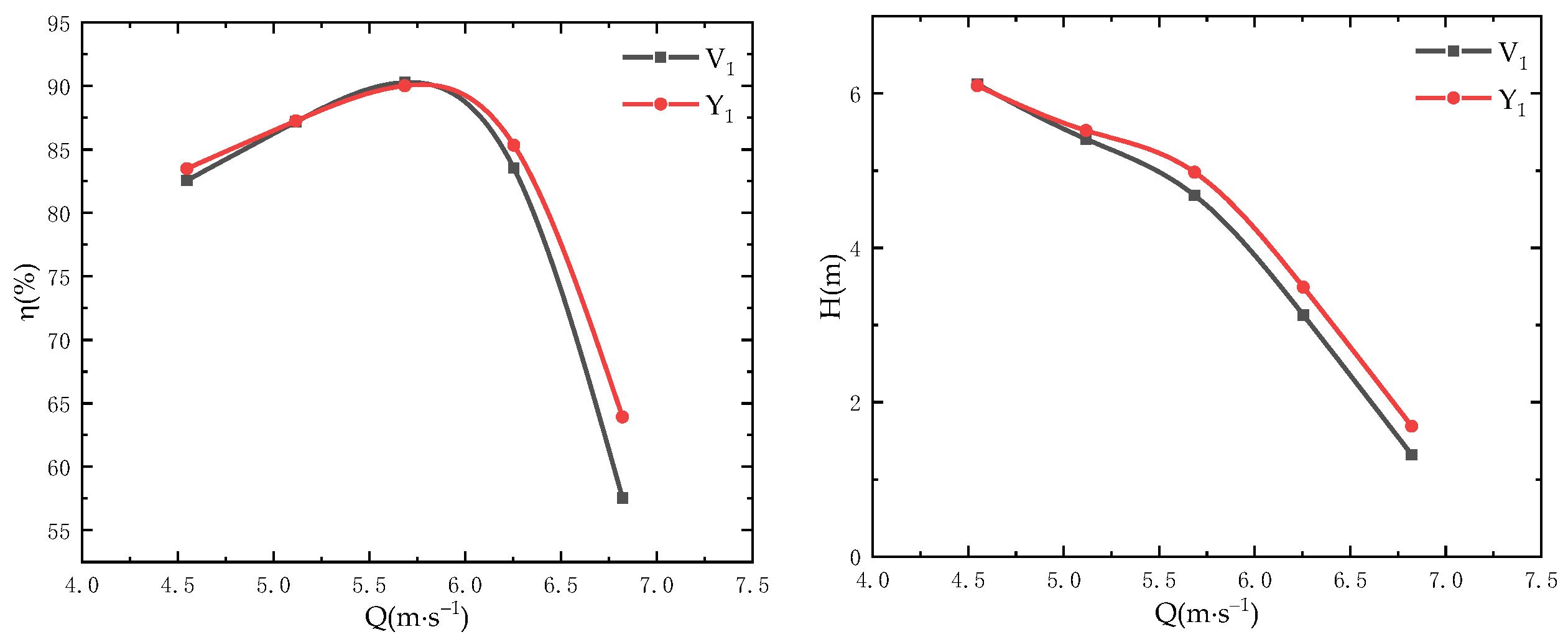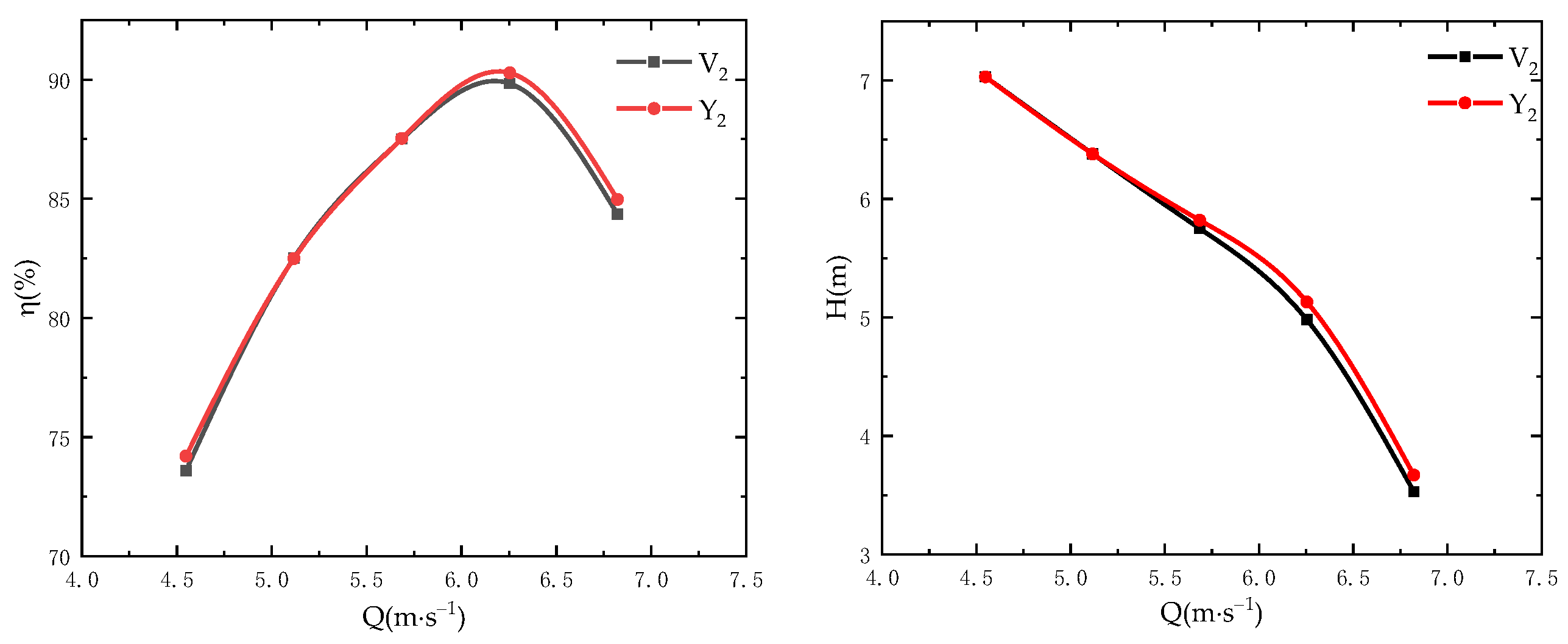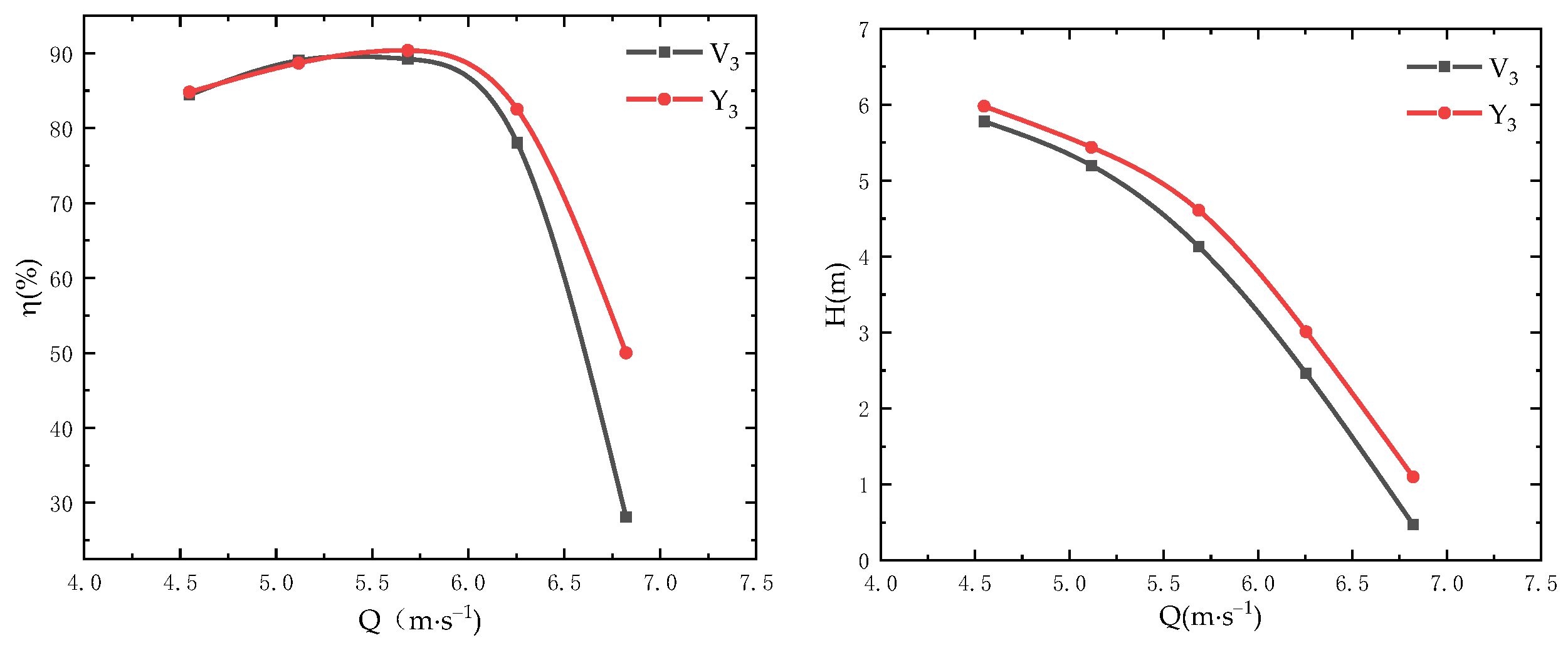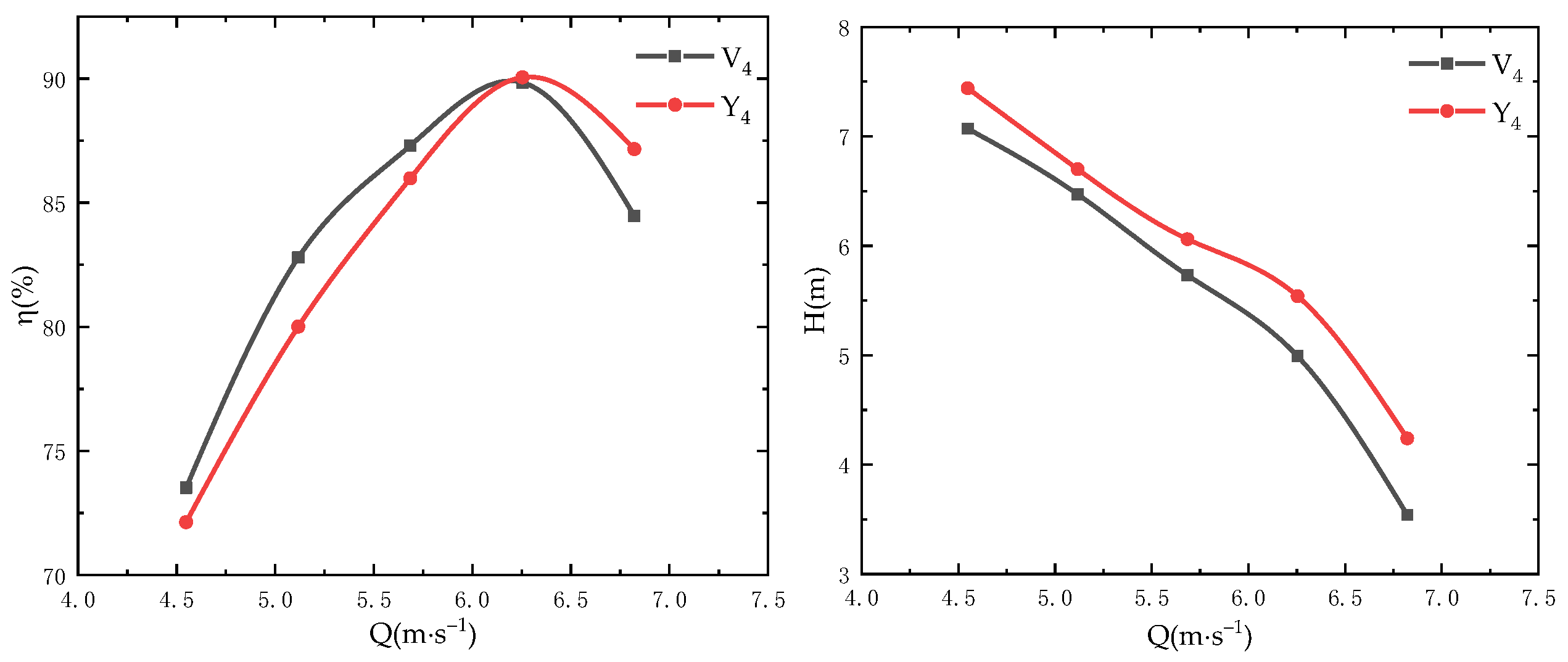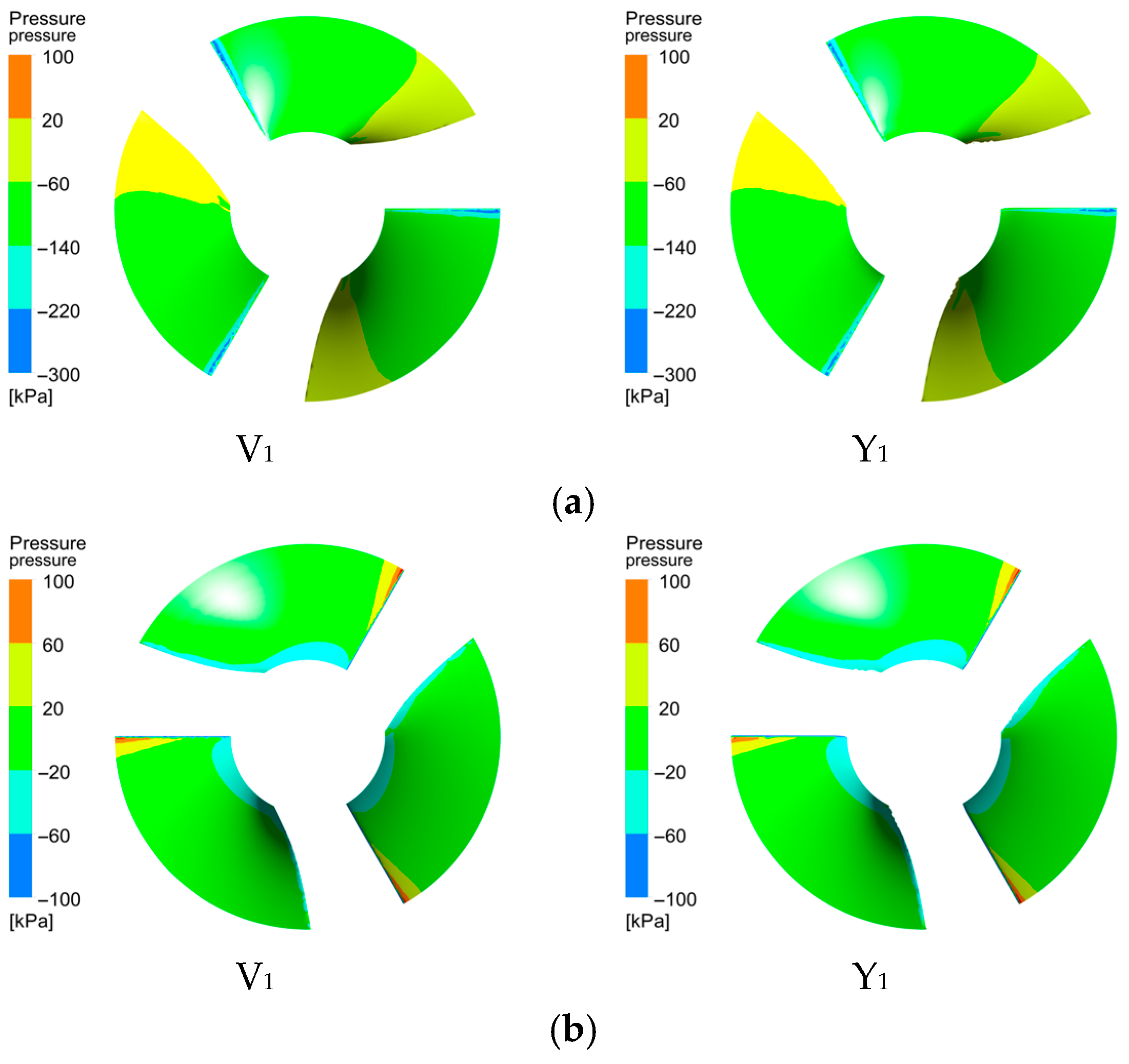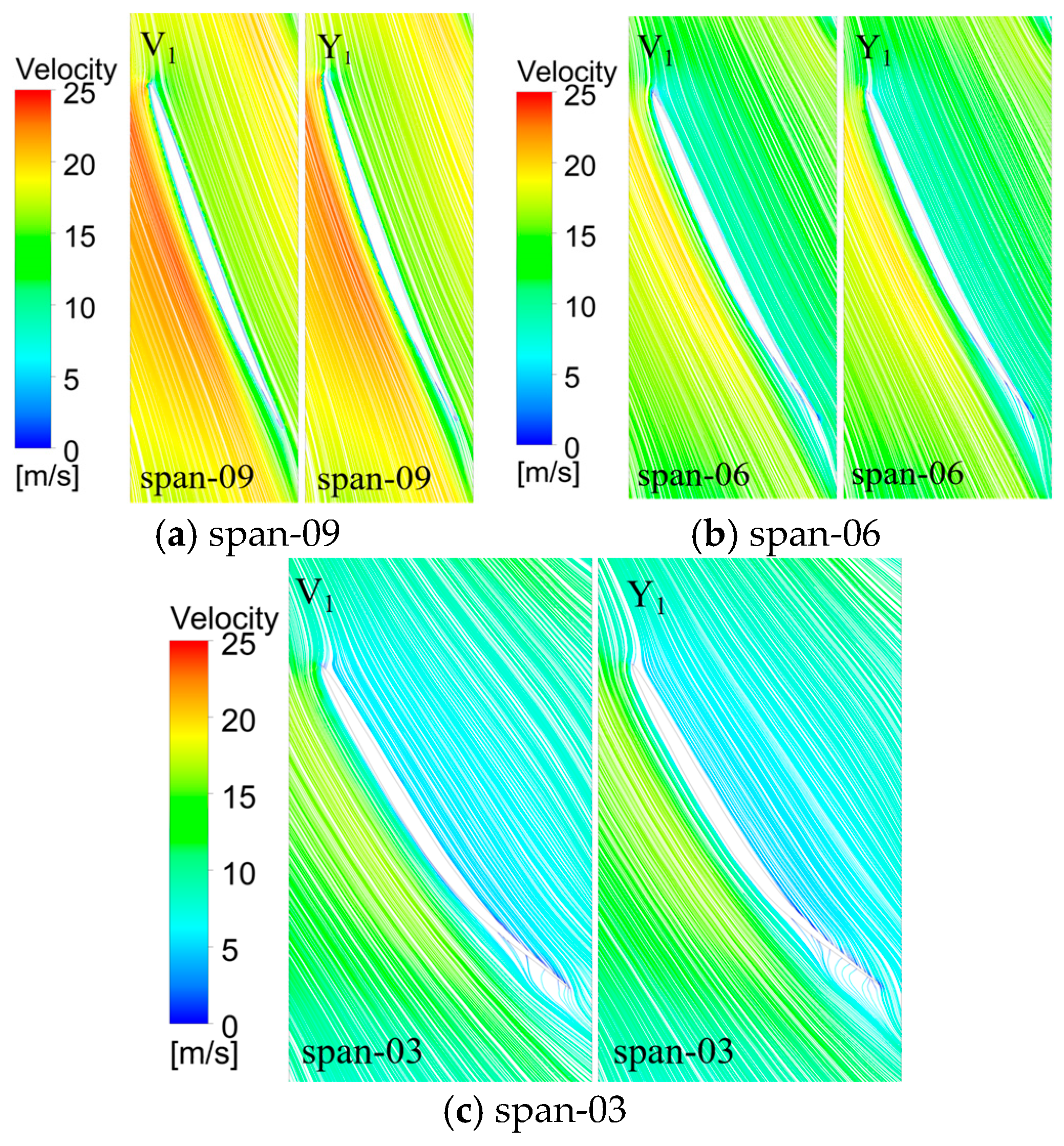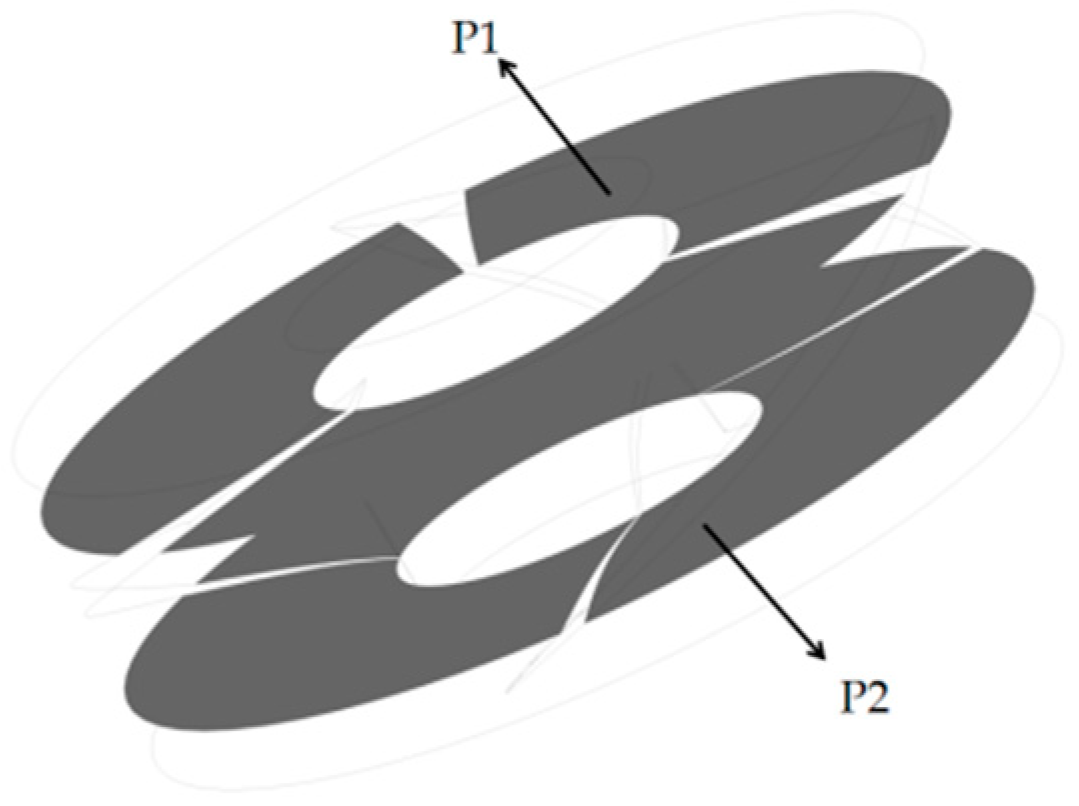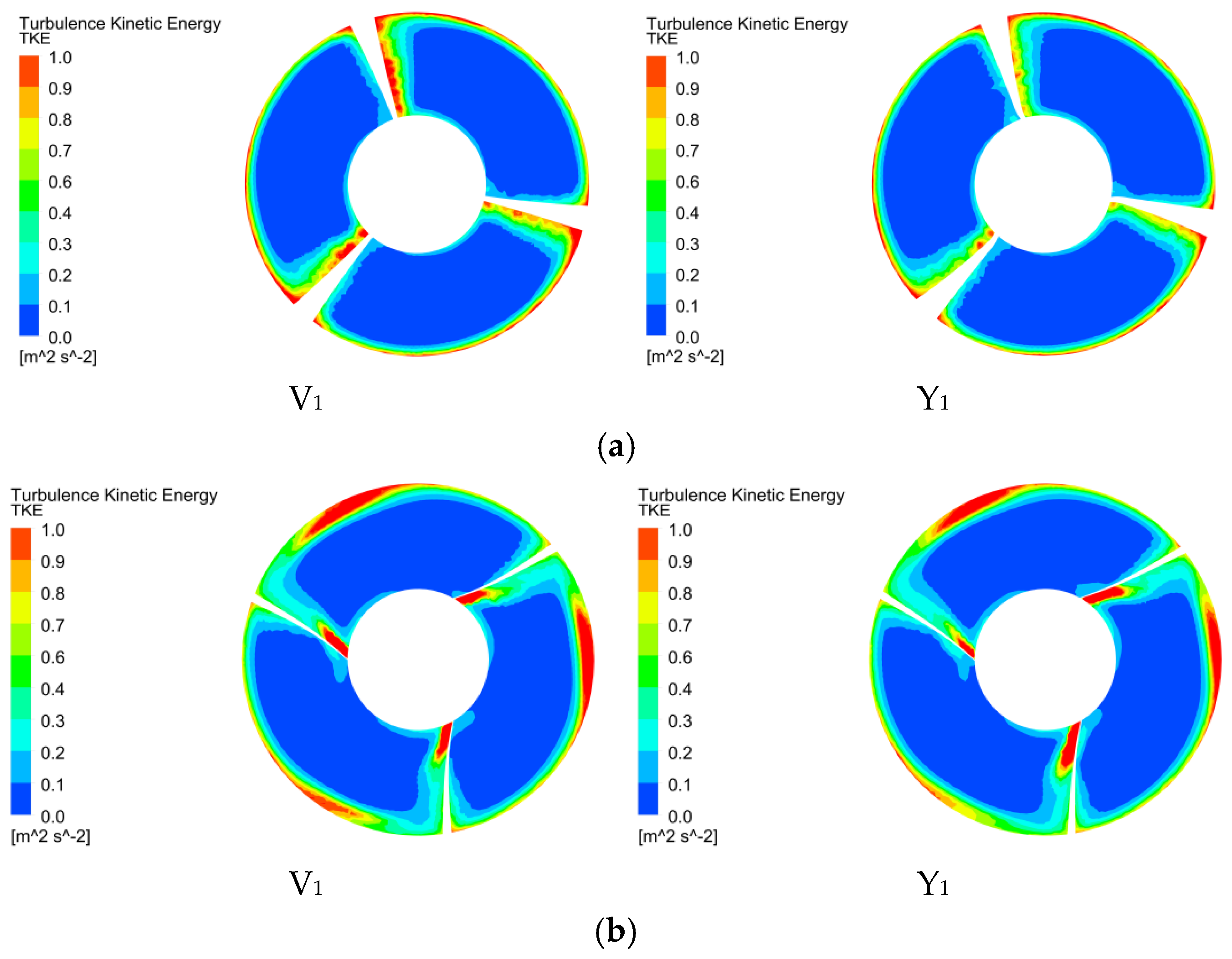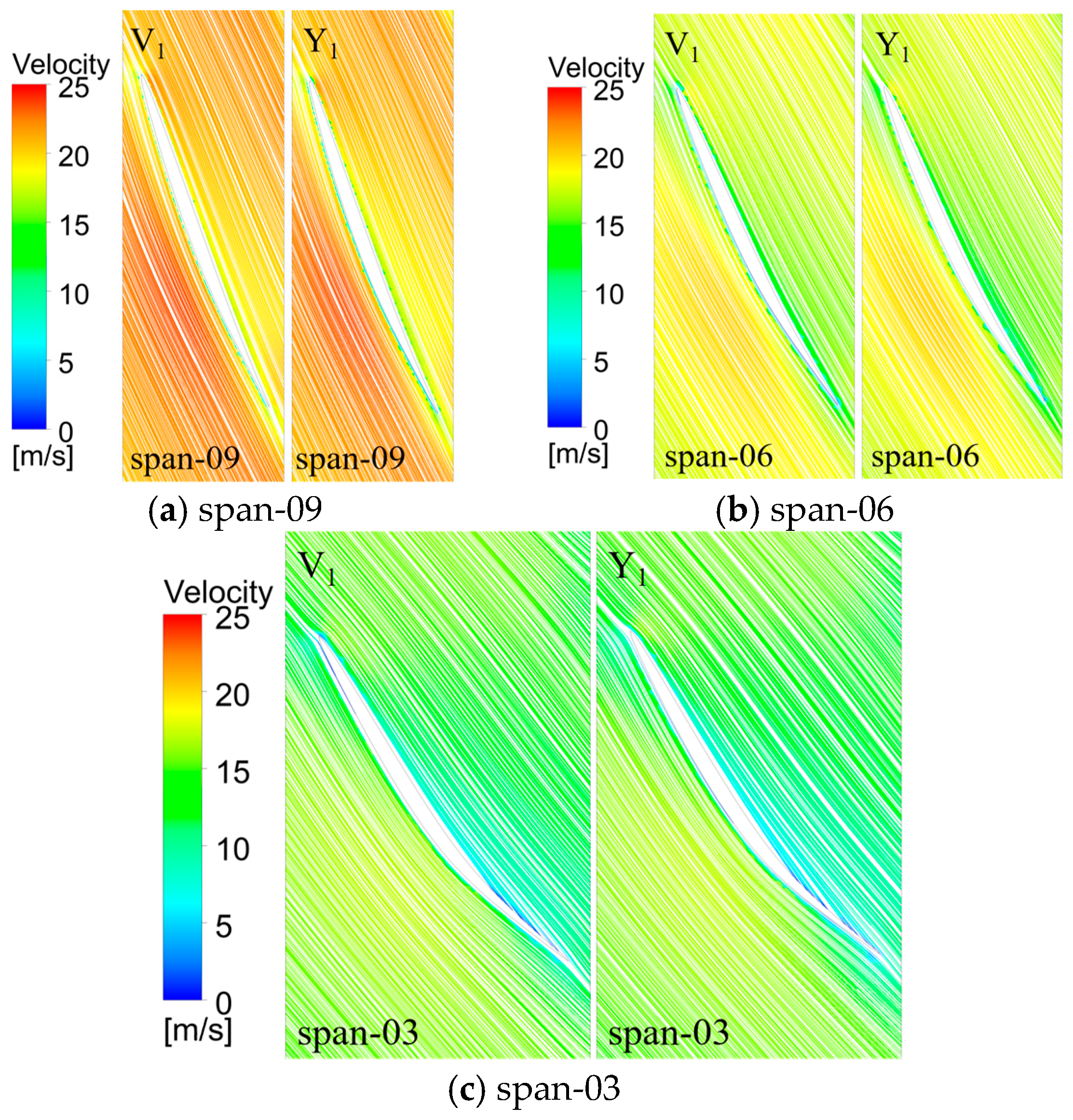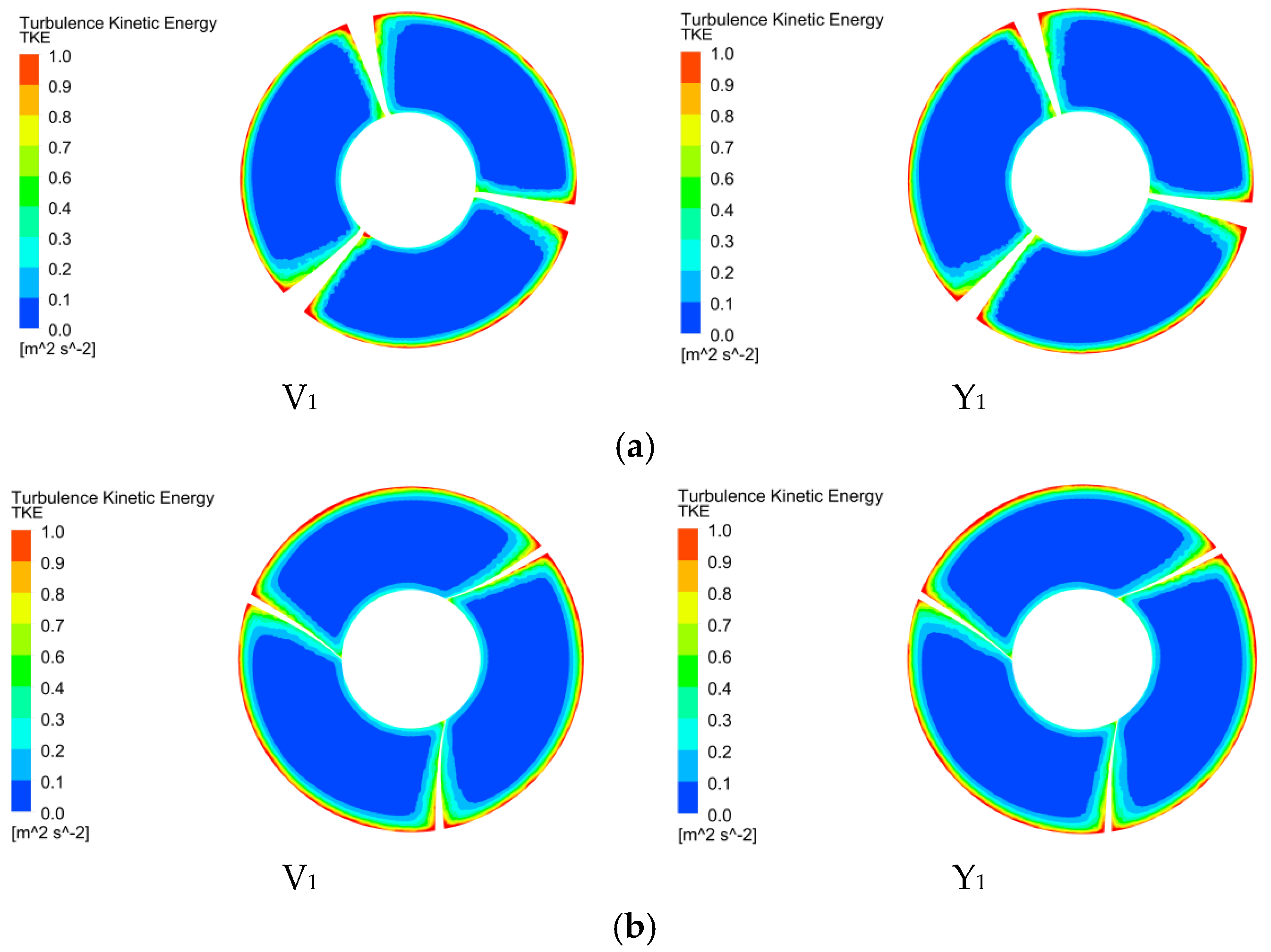1. Introduction
Axial-flow pumps represent a category of vane-type hydraulic machinery characterized by a relatively high specific speed and simple structural configuration. Owing to their high-flow, low-head characteristics; exceptional efficiency; rapid start-up capability; and operational versatility, these pumps are widely employed across diverse sectors in marine science [
1]. However, during actual operations, parameters, such as the flow rate and head, are often dynamically variable, leading to significant deviations between the actual operating point and the designed optimum [
2]. A prolonged operation under off-design conditions results in reduced hydraulic efficiency, accompanied by detrimental vibrations and cavitation phenomena. Consequently, operational adjustments are imperative to enhance pump efficiency under variable working conditions when system requirements deviate from nominal design specifications [
3]. High-efficiency axial-flow pumps play a critical role in marine applications by reducing energy consumption and enhancing desalination performance to alleviate freshwater scarcity, minimizing pollutant discharge into marine ecosystems through an enhanced wastewater treatment capacity and boosting hydraulic circulation efficiency to increase power generation outputs in tidal and wave energy systems. Research on high-efficiency axial-flow pumps profoundly impacts marine science by advancing resource exploitation, environmental protection, and technological innovation, thereby delivering substantial scientific and economic value [
4].
Common operational adjustment strategies for hydraulic systems include speed regulations, guide-vane inlet adjustments, blade-angle modifications, and varying the number of operational axial-flow pumps [
5]. Among these, blade-angle adjustments have been widely adopted as a conventional method for condition regulations [
6]. By altering the blade setting angle, this approach enables a flexible modulation of the pump flow rate and head without requiring rotational speed variations. Owing to its capacity to decouple flow-head control from speed constraints, substantial technical documentation exists on blade-angle adjustments, supported by extensive theoretical and experimental investigations conducted by domestic and international researchers [
7].
Wu Z. J. et al. [
8] conducted a three-dimensional numerical investigation of the full flow passage in an axial-flow pump, proposing four blade-setting-angle configurations under design conditions. In contrast, Chen H. X. et al. [
9] performed multi-condition numerical simulations and external characteristic calculations on the same pump model under varying blade angles, considering both steady and unsteady operating states. Their computational results were validated against experimental data, revealing vortex blockage phenomena near the hub region under low-flow conditions. Yan T. X. et al. [
10] systematically investigated the influence of guide-vane inlet setting angles on pump performance through numerical modeling, focusing on hydraulic characteristics and internal flow patterns. Their findings indicate that guide-vane angle adjustments predominantly affect the guide-vane assembly and discharge components. While moderately increasing the inlet angle enhances efficiency under high-flow conditions, excessively small angles were shown to narrow the pump’s high-efficiency operational range. Al-Obaidi A. R. et al. [
11] analyzed temporal and frequency-domain behaviors of flow fields and pressure fluctuations in axial-flow pumps through blade-angle variations. Their results demonstrate significant correlations between blade angles and distinct flow regimes, with both angular settings and unsteady flow effects substantially influencing pressure fluctuation amplitudes. Yune Sung Kim et al. [
12] evaluated the hydrodynamic impacts of propeller hub sweep angles, blade pitch angles, and inlet angles on submersible axial-flow pumps. A parametric assessment quantified the effects of rotor blade geometric parameters on the overall pump efficiency and total head characteristics. Furthermore, Yun Jeong-Eui et al. [
13] employed numerical simulations to optimize inlet guide-vane geometries and installation angles. By integrating response surface methodology with design exploration techniques, they developed an analytical framework for obtaining optimal guide-vane configurations under specified operational constraints. Sun Aoran et al. [
14] numerically investigated the effects of five inlet angles of guide vanes on axial-flow pump performance. Results demonstrate that under off-design conditions, adjusting the inlet angle of guide vanes effectively reduced incidence angles and improved internal flow patterns. Clockwise adjustments enhanced efficiency in high-flow conditions, while counterclockwise adjustments optimized performance in low-flow regimes. Shi Lijian et al. [
15] conducted numerical simulations to analyze the impact of incidence angles on axial-flow pump impeller performance. Key findings reveal that (1) increased incidence angles elevated the head and shifted the high-efficiency zone toward larger flow rates; (2) enlarging mid-span incidence angles improved both the head and efficiency under design conditions; (3) reducing hub-side incidence angles enhanced off-design performance; and (4) for constant specific speed conditions, larger incidence angles decreased the slope of head-flow curves while expanding the high-efficiency range. The aforementioned studies provide an in-depth investigation into how variable-angle adjustments affect the hydraulic performance of axial-flow pumps and the internal flow patterns within the impeller, offering valuable insights that bridge variable-angle adjustments with flow pattern analyses for the current research. However, all existing variable-angle-adjustment methods involve rotating the rigid blades of the impeller. Building upon previous research and referencing the blade placement angles discussed in these studies, this study selects appropriate variable-twist angles for the blades to examine the impact of variable-twist blades on the hydraulic performance of axial-flow pumps.
Conventional angle-adjustment strategies in axial-flow pumps rely on globally rotating rigid impeller blades to modify the blade setting angle for operational condition regulation [
16]. However, due to the inherent disparity in flow patterns between the hub and tip regions of impellers, such monolithic angular adjustments exhibit limited adaptability to diverse operating conditions and lack the capability for localized flow-field optimization. To address these constraints, this study proposes an innovative torsion-based angle-adjustment methodology utilizing variable-twist blades. By dynamically modulating the blade chord setting angle along the span-wise direction (from the hub to the tip) in response to operational demands, this approach enables graded angular reconfigurations of the blade profile. The resultant localized angle modulation allows for targeted adaptations to region-specific flow characteristics, thereby achieving enhanced hydraulic performance across varying operational conditions.
To investigate the performance enhancement capabilities of flexible variable-twist blades in axial-flow pumps, four distinct angular configurations (−1°, +1°, −2°, and +2°) were selected for the morphing blades, and a three-dimensional hydraulic model of the pump was constructed using UG NX. Numerical simulations were subsequently performed to analyze the external characteristic curves and internal flow patterns (pressure distribution, streamline topology, and turbulent kinetic energy dissipation). A comparative study was conducted to evaluate the impacts of both torsion-based and conventional rigid-blade angle-adjustment strategies on hydraulic performance and internal flow dynamics under identical angular displacements across multiple operating conditions.
2. Computational Model and Numerical Simulations
2.1. Blade Twist Deformation Method and Angle Selection
The pump blade employed in the numerical simulations incorporated 11 span-wise sections along the blade height. As illustrated in
Figure 1, these span-wise sections were sequentially numbered from 01 to 11 along the hub-to-tip direction. Span-wise section 01, which intersects with the hub, was defined as the reference plane for geometric parameterization and subsequent flow analysis.
The torsional deformation of the morphing blade was realized by rotating span-wise sections 02 to 11. In the original configuration of the pump blade, all 11 span-wise sections were initialized at a 0° blade setting angle. A rotation axis was defined by constructing a line perpendicular to the span-wise sections through the midpoint of reference plane 01, based on the baseline blade geometry. The counterclockwise direction was designated as the positive angular displacement, whereas a clockwise rotation corresponds to negative values.
Figure 2 provides a schematic representation of the −2° angular displacement applied to span-wise section 05, demonstrating the graded torsional reconfiguration strategy.
Span-wise sections 02 to 11 were sequentially rotated clockwise by 1° to generate the −1° blade configuration, designated as Group Y
1. Following this methodology, three additional configurations were constructed: +1° (Group Y
2), −2° (Group Y
3), and +2° (Group Y
4).
Table 1 systematically summarizes the angular displacement profiles across all span-wise sections for each blade configuration group.
2.2. Blade-Angle Adjustments and Angle Selections for Axial-Flow Adjustable-Blade Pumps
The angle-adjustment mechanism of conventional axial-flow adjustable-blade pumps fundamentally differs from the torsion-based approach. In traditional rigid-blade systems, angular modulation is achieved through an integral rotation of the entire blade assembly about a defined axis. A rotation axis is established at the midpoint of the root span-wise section (blade base), aligning with the torsional reference frame of variable-twist blades. Consistent with the established convention, a counterclockwise rotation corresponds to a positive angular displacement, while a clockwise rotation corresponds to negative values.
Figure 3 schematically illustrates this monolithic angular adjustment strategy, with
Table 2 providing the blade-angle adjustments for axial-flow adjustable-blade pumps.
2.3. Selection of Comparison Groups
To systematically evaluate the performance-enhancement capabilities of variable-twist blades versus conventional axial-flow adjustable-blade pumps under varying operational conditions, comparative groups were established based on the four angles for both blade configurations.
Table 3 comprehensively outlines the experimental grouping scheme. This study meticulously investigates the performance-enhancement of variable-twist blades compared to conventional axial-flow propeller pumps under four distinct angle-adjustment conditions (−1°, +1°, −2°, and +2°). All angle modifications were systematically implemented using a standard blade designed with 0° as the reference configuration, while maintaining consistent geometric properties for the blade length, cross-sectional chord length, and thickness throughout the design process.
2.4. Modeling and Mesh Generation of the Axial-Flow Pump
The 350ZLB-100 axial-flow pump was selected as the research prototype (manufactured by Jinan Taida Pump Industry Co., Ltd., Jinan City, Shandong Province, China). A three-dimensional model of the pump unit was developed using the UG NX software (version 12.0). Key design specifications include a rated flow capacity of 401.64 L/S, a rated head of 4.80 m, a rotational speed of 1450 rpm, an impeller diameter of 0.3 m, 3 impeller blades, and 5 guide vanes (
Figure 4).
Given the requirement for variable blade-twist angles in this study and the structural complexity of the impeller blades, structured grids prove inadequate for accommodating the torsional deformation of the blades, presenting significant grid-generation challenges and yielding unsatisfactory grid quality that compromises computational accuracy. Consequently, unstructured grids with superior geometric adaptability were employed for the impeller domain in the numerical simulations. Local grid refinements were implemented in the blade regions to increase grid density, thereby ensuring enhanced computational precision.
Figure 5 shows a mesh diagram of the axial-flow pump section.
The computational domain was discretized using unstructured mesh, which demonstrates superior adaptability to the geometric complexity of the pump assembly. Localized mesh refinements were strategically implemented in regions with high velocity/pressure gradients to ensure solution accuracy while maintaining computational efficiency [
17]. Five distinct mesh configurations with progressive resolution levels (1.9 million, 2.4 million, 2.8 million, 3.8 million, and 4.4 million cells) were generated for mesh independence verification. A systematic mesh convergence analysis was performed under design operating conditions [
18], with the quantitative results of key performance metrics presented in
Table 4 and
Figure 6.
The computational-domain meshing process revealed that an increased mesh density improves resolution accuracy in resolving internal flow-field characteristics within the pump [
19]. As shown in
Figure 6, hydraulic performance parameters (efficiency) reached peak values and stabilized at 3.8 million elements, with the corresponding mesh configuration achieving minimum orthogonal quality exceeding 0.2. Based on this asymptotic convergence behavior, it was determined that further mesh refinements beyond 3.8 million elements exerted negligible influence on the computational results. Consequently, a mesh configuration of 3.8 million elements was adopted for subsequent numerical simulations.
2.5. Numerical Simulations and Boundary Condition Setup
The flow of water inside the pump can be treated as a three-dimensional, incompressible, viscous turbulent flow. For numerical simulations, the governing equations of fluid mechanics were used to formulate and solve the system of equations [
20]. These fundamental equations include the continuity equation, energy equation, and momentum equation [
21]. Since heat exchange is not considered, the governing equations were simplified to the following two:
The mass conservation equation for fluids, also known as the continuity equation [
22], is expressed as follows:
In this equation, represents the density, represents time, and represents the velocity vector.
- 2.
Momentum Equation:
For viscous incompressible fluids, the momentum equation, also known as the N-S equation, is expressed as follows [
23]:
In this equation, represents the density, represents time, represents the dynamic viscosity, represents the velocity vector, and represents the source term.
The Reynolds number was calculated as follows:
In this equation, represents the density, represents the velocity vector, represents the dynamic viscosity, and represents the hydraulic diameter.
The numerical simulations in this study were conducted at 25 °C, with the water density set to 1000 kg/m3 and with a hydraulic diameter of 1.7 m. Under the design operating conditions, the inlet flow velocity of the pump was 5.685 m/s, yielding a Reynolds number (Re) of 1.08 × 107.
This numerical simulation was conducted under high-Reynolds-number conditions and employed a steady-state approach. Given these parameters, the standard turbulence model is well-suited for rotating machinery simulations due to its robustness and adaptability in capturing turbulent flow characteristics within axial-flow pumps. Consequently, the standard turbulence model was adopted for the current study.
The standard
turbulence model is capable of meeting the requirements for numerical simulations of rotating machinery [
24]. It exhibits strong adaptability and can effectively capture the turbulent flow characteristics inside axial-flow pumps. Therefore, the standard
turbulence model was adopted for this numerical simulation [
25].
In this equation, = 1.44, = 1.92, = 1.0, and = 1.3.
4. Conclusions
Diverging from conventional axial-flow adjustable-blade pump angle-adjustment strategies, this study proposes a torsion-based angle modulation scheme through blade deformation, selecting four angular configurations ( −1°, +1°, −2°, and +2°) to investigate the hydraulic performance impacts of variable-twist versus rigid-blade systems under identical angular displacements across operating conditions. Comprehensive analyses were conducted on external characteristic curves, pressure distributions, streamline patterns at fixed span-wise sections, and turbulent kinetic energy profiles at defined impeller cross-sections, elucidating the hydrodynamic improvements of variable-twist blades in internal flow regulation.
An analysis of external characteristic curves demonstrated consistent efficiency and head trends between both angle-adjustment strategies under identical angular configurations across flow regimes, validating the feasibility of torsion-based modulation. The results demonstrate that compared with rigid blades, the efficiency of variable torsion blades is not significantly improved under low-flow conditions. Under high-flow conditions (1.2 Q), the torsion-based angle-adjustment strategy exhibits superior efficiency across all four angular positions: −1° configuration: 11.1% efficiency improvement; +1° configuration: comparable efficiency; −2° configuration: 7.8% efficiency improvement; and +2° configuration: 3.2% efficiency improvement. The differential efficiency enhancements across the four angular groups confirm the superior hydraulic performance of variable-twist blades, particularly under high-flow conditions.
An internal flow analysis demonstrated that under the 0.8 Q condition, the variable-twist blade configuration optimizes inflow alignment at the impeller inlet and outflow uniformity in the tip region compared to rigid-blade counterparts, reducing turbulent losses at the impeller’s inlet/outlet zones. Meanwhile, under the 1.2 Q condition, it enhances hub-side and mid-span inflow attachment while suppressing turbulent kinetic energy dissipation at the discharge, thus proving that torsion-based blade modulation effectively improves hydrodynamic stability and energy transfer efficiency within the impeller domain.
Building upon the present research framework, future investigations should examine the effects of variable-twist blades on cavitation characteristics and pressure pulsation behavior within the impeller domain under diverse operating conditions. Additionally, expanding the range of torsional deformation angles for variable-twist blades would enable a comprehensive evaluation of broader angular variations on overall hydraulic performance.

